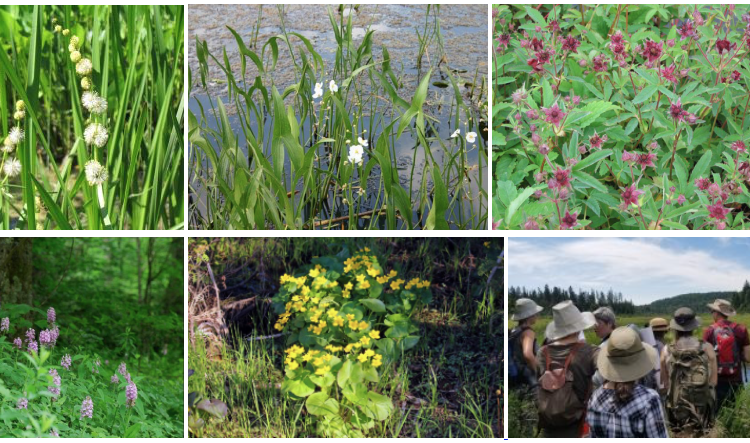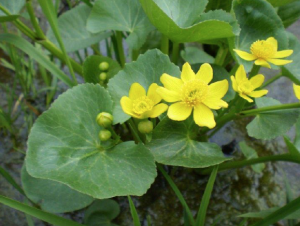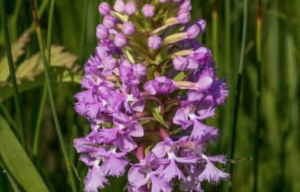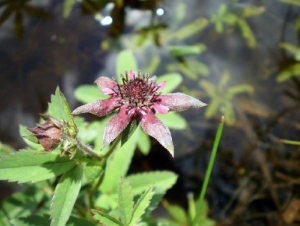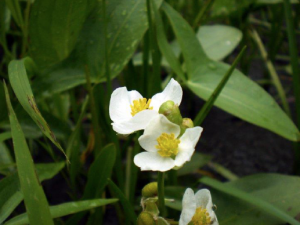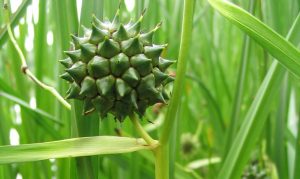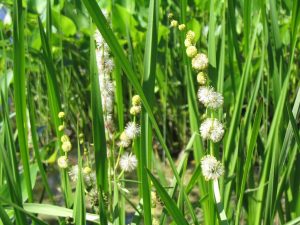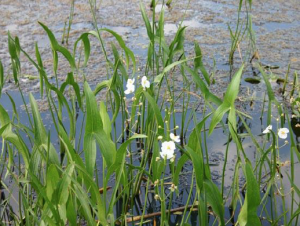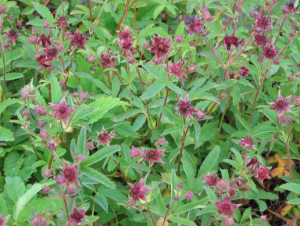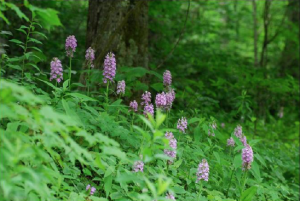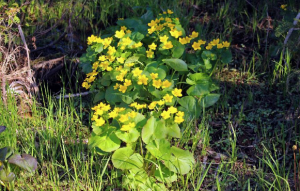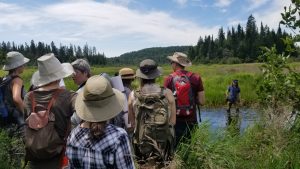Every vote counts in 2019! We have identified five plant species as possible emblems for our organization and we invite you to CHOOSE YOUR FAVOURITE ONE from among the finalists. The initiative is organised in the context of the upcoming International Year of Plant Health 2020.
- Caltha palustris, populage des marais, marsh marigold
- Plathanthera grandiflora, planthanthère à grandes fleurs, greater purple fringed bog orchid
- Potentilla palustris, potentille des marais, marsh cinquefoil
- Sagittaria latifolia, sagittaire latifoliée, broad-leaved arrow-leaf
- Sparganium eurycarpum, rubanier à gros fruits, broad-fruited bur-reed
[Descriptions: see the bottom of the page]
[Voting closes on November 1, 2019]
The winning plant will be announced at our next annual general meeting before December 2019. Come to a free presentation at Chalet Bellevue in Morin-Heights and be the first to learn about the watershed’s emblematic plant.
Neither too rare nor too common – they are all magnificent!
All five species can be found in the RJANP area, and each one can be easily spotted and identified. We saw most of them at the July 2019 RuisseauBlitz.
These plants, which are underrepresented in illustrating the importance of nature conservation, grow in fragile environments like those surrounding Ruisseau Jackson: mature woods, dense stands and forest wetlands. These areas are becoming increasingly rare, and it is RJANP’s mission to protect them. It is no surprise then that Ruisseau Jackson’s presence is important, if not essential, to the survival of these five species.
The contenders for the role of emblematic plant were selected according to the following criteria:
- They must not currently be an emblematic plant (e.g.: Iris versicolor, Quebec’s floral emblem);
- They have to be found in the Ruisseau Jackson watershed;
- They have to grow in a wetland or aquatic environment, which are important ecosystems for RJANP because they help build community interest in conserving these environments;
- They should be esthetically pleasing or surprising;
- They should be of some interest to residents and those who spend time in the protected area, be of some use, enhance the area or have an interesting history.
How do you choose?
To help you decide which is your favourite species, check out the following fact sheets prepared by biologist Mathieu Madison and let the plants work their magic on you.
Vote before November 1, 2019! Spread the word! There are no wrong answers.
https://fr.surveymonkey.com/r/J22G9LF
The finalists
(1) Caltha palustris, populage des marais, marsh marigold
| Latin name | Caltha palustris |
| Common names (EN) | Marsh marigold, kingcup, cowslip |
| Common names (FR) | Populage des marais, souci d’eau |
| Botanical family | Ranunculaceae, buttercup family |
| Floral type | Herbaceous perennial |
| Adaptation capacity | Pioneer plant, among the first to establish themselves |
| Type of habitat | Marshes and fens |
| Global distribution | North America and Eurasia, temperate and boreal zones |
| IUCN status | LC: least concern, stable populations |
| Position in relation to streams | Very near the water or in shallow water |
| Pattern of dispersal | Clumped distribution, in clusters or small groups |
| Flowering period | Spring, May and June |
| Reproduction strategy | Multiple flowers per plant, many seeds (200) per flower. Seed dispersal on water. |
| Interesting facts | Edible young shoots and flower buds in spring. Medicinal, diuretic and expectorant. The plant roots contain an alkaloid similar to nicotine.
|
(2) Plathanthera grandiflora, greater purple fringed bog orchid, planthanthère à grandes fleurs
| Latin name | Platanthera grandiflora |
| Common name (EN) | Greater purple fringed orchid |
| Common names (FR) | Platanthère fimbriée, plantathère à grande fleurs |
| Botanical family | Orchidaceae, orchid family |
| Floral type | Herbaceous perennial |
| Adaptation capacity | Climax plant, tolerant of competition |
| Type of habitat | Fens and damp woods |
| Global distribution | Eastern North America, temperate zones |
| IUCN status | LC: least concern, stable populations |
| Position in relation to streams | Farther away from the water, sometimes on the stream bank |
| Pattern of dispersal | Random, but localized |
| Flowering period | Summer, June to August |
| Reproduction strategy | Plant invests a lot of energy in the seeds, but doesn’t produce very many. |
| Interesting facts | Native Quebec orchid. Its presence confirms a certain level of maturity in the ecosystem given the plant’s strong sensitivity to disturbances. Considered to be a giant P. psycodes, a similar orchid with which it could be crossbred. |
(3) Potentilla palustris, marsh cinquefoil, potentille des marais
| Latin name | Potentilla palustris |
| Common names (EN) | Marsh cinquefoil, purple marshlocks |
| Common names (FR) | Potentille des marais, comaret, argentine rouge |
| Botanical family | Rosaceae, rose family |
| Floral type | Herbaceous perennial |
| Adaptation capacity | Pioneer plant, among the first to establish themselves |
| Type of habitat | Marshes and fens |
| Global distribution | Northern hemisphere, circumboreal |
| IUCN status | LC: least concern, stable populations |
| Position in relation to streams | Very near water in variable soils and on riparian fallow land |
| Pattern of dispersal | Uniform, but variable, and also in large colonies |
| Flowering period | Summer, June to August |
| Reproduction strategy | Creeping rhizome, few seeds per plant |
| Interesting facts | Often separated from the Potentilla genus, under the name Comarum palustris.
Relative of some ornamental strawberry hybrids. Edible, dried leaves used in herbal tea. Root contains a black dye. |
(4) Sagittaria latifolia, broad-leaved arrow-leaf, sagittaire latifoliée
| Latin name | Sagittaria latifolia |
| Common names (EN) | Broad-leaved arrow-leaf, duck potato |
| Common name (FR) | Sagittaire latifoliée |
| Botanical family | Alismataceae, water plantain family |
| Floral type | Herbaceous perennial |
| Adaptation capacity | Climax plant, likes environments rich in nutrients and organic matter. |
| Type of habitat | Marshes and fens |
| Global distribution | North America and Mexico |
| IUCN status | LC: least concern, stable populations |
| Position in relation to streams | Rises above the water. |
| Pattern of dispersal | Uniform, but variable, and also in large colonies |
| Flowering period | Summer, June to August |
| Reproduction strategy | Creeping rhizome, few seeds per plant |
| Interesting facts | Rhizome internodes form tubers harvested and stored in caches by beavers and muskrats. Some Amerindian tribes look for and appropriate these caches as a food source. Excellent roasted, has sweet chestnut flavour. |
(5) Sparganium eurycarpum, broad-fruited bur-reed, rubanier à gros fruits
| Latin name | Sparganium eurycarpum |
| Common names (EN) | Broad-fruited bur-reed, common bur-reed |
| Common name (FR) | Rubanier à gros fruits |
| Botanical family | Sparganiaceae, reed family |
| Floral type | Herbaceous perennial |
| Adaptation capacity | Climax plant, likes environments rich in nutrients and organic matter. Resistant to disturbances. |
| Type of habitat | Marshes and fens |
| Global distribution | North America and Eurasia, temperate and boreal zones |
| IUCN status | LC: least concern, stable populations |
| Position in relation to streams | Rises above the water. |
| Pattern of dispersal | Uniform, but variable, and also in large colonies |
| Flowering period | Summer, June to August |
| Reproduction strategy | Plant invests a lot of energy in the seeds, but doesn’t produce very many. Creeping rhizomes and large seeds with lots of reserves. |
| Interesting facts | Pollinated by wind. Male flowers at the top of the floral pole open after the female flowers.
The rhizomes are a food source for muskrats. Edible: cooked rhizomes have a slightly sweet flavour. Seeds are a food source for ducks. |

